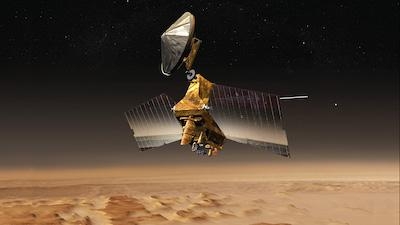Thu, Feb 22, 2018
Sensed Unexpectedly Low Battery Voltage
NASA's Mars Reconnaissance Orbiter (MRO), at Mars since 2006, put itself into a precautionary standby mode on Feb. 15 in response to sensing an unexpectedly low battery voltage.

The orbiter is solar-powered but relies on a pair of nickel-hydrogen batteries during periods when it is in the shadow of Mars for a portion of each orbit. The two are used together, maintaining almost identical charge during normal operations.
The spacecraft remains in communication with Earth and has been maintaining safe, stable temperatures and power, but has suspended its science observations and its service as a communications relay for Mars rovers. Normal voltage has been restored, and the spacecraft is being monitored continuously until the troubleshooting is complete.
"We're in the diagnostic stage, to better understand the behavior of the batteries and ways to give ourselves more options for managing them in the future," said MRO Project Manager Dan Johnston of NASA's Jet Propulsion Laboratory, Pasadena, California. "We will restore MRO's service as a relay for other missions as soon as we can do so with confidence in spacecraft safety -- likely in about one week. After that, we will resume science observations."
NASA's Mars Reconnaissance Orbiter entered orbit around the Red Planet on March 10, 2006. Since then, it has returned more data than all other past and current interplanetary missions combined, with a tally of more than 317 terabits so far.
The mission met all its science goals in a two-year primary science phase. Five extensions, the latest beginning in 2016, have added to the science returns. The longevity of the mission has given researchers tools to study seasonal and longer-term changes on Mars. Among other current activities, the orbiter is examining possible landing sites for future missions to Mars and relaying communications to Earth from NASA's two active Mars rovers.
(Image provided with NASA news release)
More News
From 2023 (YouTube Version): Legacy of a Titan Robert (Bob) Anderson Hoover was a fighter pilot, test pilot, flight instructor, and air show superstar. More so, Bob Hoover was an i>[...]
Get The Latest in Aviation News NOW on Instagram Are you on Instagram yet? It's been around for a few years, quietly picking up traction mostly thanks to everybody's new obsession >[...]
Aero Linx: B-52H Stratofortress The B-52H Stratofortress is a long-range, heavy bomber that can perform a variety of missions. The bomber is capable of flying at high subsonic spee>[...]
Altimeter Setting The barometric pressure reading used to adjust a pressure altimeter for variations in existing atmospheric pressure or to the standard altimeter setting (29.92).>[...]
"Knowing that we play an active part in bettering people's lives is extremely rewarding. My team and I are very thankful for the opportunity to be here and to help in any way we ca>[...]
 Classic Aero-TV: Remembering Bob Hoover
Classic Aero-TV: Remembering Bob Hoover ANN FAQ: Follow Us On Instagram!
ANN FAQ: Follow Us On Instagram! ANN's Daily Aero-Linx (05.15.24)
ANN's Daily Aero-Linx (05.15.24) ANN's Daily Aero-Term (05.15.24):Altimeter Setting
ANN's Daily Aero-Term (05.15.24):Altimeter Setting Aero-News: Quote of the Day (05.16.24)
Aero-News: Quote of the Day (05.16.24)



